Step by Step on The Way of Saint James
From San Juan de Ortega to Burgos
22 May 2018
Stage 12 – 26 Km

Today’s weather forecast predicts rain, but looking outside, I see clear skies.
– All the better! I really hope the forecast is wrong this time. –
As usual, the early morning temperature, although bearable, is quite cool.
Before leaving the hostel, I have a frugal breakfast, eating some biscuits I had with me and grabbing a cappuccino from the vending machine.
In hostels, apart from a few rare exceptions, breakfast is never provided; however, most of them have vending machines for drinks, coffee, and even snacks.
At 6:25, I leave the hostel, and within a few minutes, I am already outside the small village of San Juan de Ortega.
Today’s destination is Burgos, an important city in Castilla y León.
Since it’s a large urban center, I suggest to Rocco and Dante that we stay there for two nights, giving us time to visit the city’s attractions.
At the same time, we can also take the opportunity for a rest day, considering we’ve been walking for twelve consecutive days and have covered over 280 kilometers—about one-third of the entire Way of Saint James.
These are our general plans for Burgos, but for now, we need to focus on completing today’s stage.
***
Just after leaving San Juan de Ortega, we first pass through a small oak forest, and then the dirt track we follow as the sun rises takes us back into wide-open fields.
Along the way, we see stones arranged on the ground in concentric circles, with a small mound at the center of the rings.
They look exactly like the patterns seen in Japanese Zen gardens.
They’re beautiful to see, but I don’t know who made them or what they mean.
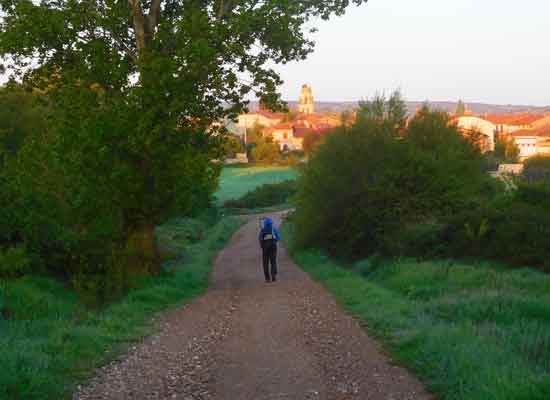
The first village I come across is Agés, where I take advantage of an inviting open café filled with delicious treats to have a proper breakfast with apple pie and orange juice.
I also buy a good “empanada” to save for later, just in case I don’t find anything else along the route.
Here, I meet many fellow pilgrims, including Spaniards Juanì and Salvador, as well as Giovanna from Sassari, who is walking alongside Silvia.
The Way creates “fluid” groups—clusters of pilgrims whose members change frequently, naturally, and without any fixed structure.
– Sharing the experience with many people is just as rewarding as walking alone for many kilometers. –
Readers of this account will have noticed, and will continue to notice, frequent shifts between singular and plural forms; this reflects my alternating experiences, sometimes walking alone and sometimes in the company of other pilgrims, even within short periods.
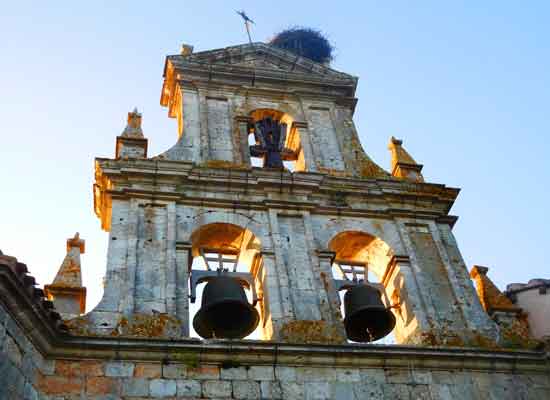
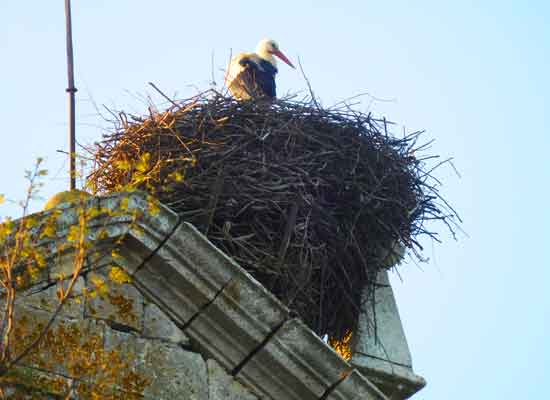
***
Before leaving Agés, I can’t resist photographing the Iglesia de Santa Eulalia de Mérida for my church collection. Built in the 16th century in Gothic style atop a Romanesque temple, it’s an impressive structure.
At the highest point of the bell tower, storks have made their home, building a massive nest.
Despite the gloomy weather forecast, the day continues to be pleasant: the sun is shining, the temperature is perfect, and I had a good breakfast; I’ve interacted with lovely people, and I’m still feeling physically strong.
– What more could I ask for? –
For all these reasons, my spirits are high, and I continue walking with great satisfaction.
After Agés, the next village I pass through is Atapuerca.
This small locality is globally significant due to its prehistoric site, which UNESCO has designated as a World Heritage site.
Here, archaeologists discovered hominid bones containing human DNA, the oldest ever found anywhere in the world.
This discovery led scientists to rethink the theory of human evolution.
Despite its interest, I decide not to stop and visit the site, especially since reaching it requires a three-kilometer detour and the guided tours operate at fixed times.
Outside the village, I resume walking along a dirt track. From here, the path ascends until it reaches the summit of the Sierra de Atapuerca.
After almost three kilometers, at just before 9:00 AM, I arrive at an altitude of 1,060 meters, where there’s a wide, rocky plateau.
The area is marked by a simple wooden cross, with a pile of stones left by travelers at its base, and a large iron sign featuring a quote from a book by Luciano Huidobro Serna—a priest born near this spot in the 19th century.
The inscription praises the stunning panoramic view that stretches out as far as the eye can see.
According to the priest, this view of the Burgos plain is the most beautiful one along The Way of Saint James, second only to the Pyrenees seen from Burguete in Navarra.
In the distance, I can already make out Burgos and can clearly distinguish the cathedral towers.
Seeing the city, I get the impression that I’ll soon arrive at my destination. However, the walk is still long, and several kilometers remain before I reach the finish.
The Burgos plain can be considered the start of the so-called “mesetas,” a Spanish term meaning “plateaus.”
The Iberian Peninsula’s steppe is an endless, slightly undulating expanse; situated at an average altitude of 800–900 meters, it begins in Burgos and stretches to León.
It’s a treacherous desert because, with its fields of cereals, sunflowers, and vines, it appears welcoming. However, its harsh climate is ready to punish anyone who crosses it.
This section of The Way challenges pilgrims, whether in summer with scorching sun and high temperatures or in winter with ice, wind, and freezing cold.
There are no trees for shade during the summer months, and water sources to refill bottles are scarce.
Even villages where one might stop to rest, regain strength, and eat are relatively far apart.
For the pilgrim walking these lands, solitude is often the only companion.
***
Having crossed the Alto de la Sierra de Atapuerca, the path continues downhill.
In this stretch, the beautiful view of the Burgos plain is slightly marred by a telecommunications antenna installation and an industrial quarry extracting limestone.
Aside from this detail, the rest of the route is pleasant.
Just before Cardeñuela Riopico, a disused double-decker bus, reminiscent of the London style, stands by the roadside advertising the Albergue Via Mina, located a bit further ahead.
It’s impossible to miss, as its exterior is entirely covered with colorful and whimsical illustrations related to The Way of Saint James.
At the entrance of the small village, I stop at Bocateria San Miguel, where I find Rocco and Dante sitting at a table enjoying a snack.
I take the opportunity for a break and eat the “empanada” I bought this morning.
Besides the two of them, there are several other pilgrims recharging under the pleasant spring sun. Among them is an amiable 80-year-old Japanese man whom I’ve encountered several times since Roncesvalles.
Unfortunately, I struggle to remember the names of people from the East, but I find it easier to recall their cities of origin.
So, with this sprightly octogenarian, I only remember that he lives in Kobe, a city in central Japan facing Osaka Bay.
To have a keepsake, I take the chance to snap a photo with him before we continue.
My stop in Cardeñuela Riopico is fairly short, lasting about ten minutes.
As I walk through the small village, I don’t miss the opportunity to photograph the Iglesia de Santa Eulalia de Mérida, a 16th-century Renaissance church with a magnificent Pietà carved into its façade.
A large, recently painted mural on the white façade of a house catches my eye. While it may lack artistic value compared to the church, it’s certainly impactful and amusing.
The humorous illustration depicts a pilgrim, exhausted from the weight of his enormous backpack and the long walk, daydreaming—inside a thought bubble—about being comfortably seated in an armchair at home.
Today’s pilgrims, unlike those of the past, undoubtedly benefit from many conveniences and comforts that help them tackle the long journey.
Nevertheless, walking to Santiago de Compostela, and even further to Finisterre, covering almost 900 kilometers in over a month solely by one’s own effort, is no small feat.
Fatigue, soreness, heat, cold, rain, and more—these are challenges that one must face sooner or later.
There’s no fixed organization; everything is improvised. Even the planned stops may not always align with the intended goals.
Step by step, problems are faced one at a time. Eating, drinking, washing, and sleeping are not always guaranteed and depend on opportunities along the way.
The motivations for walking this path to the tomb of Saint James vary: religiosity, spirituality, self-discovery, or simply personal choice.
Whatever the reason, it’s a unique journey that forever changes those who complete it, leaving an indelible mark deep in their soul.
***
Before reaching Burgos, I pass through one last village: Orbaneja Ríopico.
Although I don’t stop here, I make a brief detour to glance at the simple Iglesia de San Millán Abad, perched on a small hill.
It’s just past eleven when I start to feel I’ve arrived in Burgos.
But this, too, turns out to be an illusion. From the outskirts to the city center, I still have ten kilometers to go—over two more hours of walking.
After crossing the bridge over the Autovía del Norte, I reach a fork in the road offering two routes into the city.
I take the left path. For three long, monotonous kilometers, I walk alongside the airport fence until I reach Castañares, a district of Burgos.
The last three kilometers of today’s stage lead through a city park.
Walking with me are Rocco and Dante, and together we follow the long, straight avenue that runs along the Río Arlanzón.
The park is green and relaxing; the sun is shining, and the temperature is just right.
Taking advantage of the lovely spring day, many people are jogging, while others are simply strolling.
Among those walking is an elderly man who stops us to ask if we’re heading to a hostel.
– A rhetorical question, obviously! –
Given our clothes, the backpacks on our shoulders, our tired faces after many kilometers, and the fact that we’re on the route to Santiago de Compostela, we can only be pilgrims in search of accommodation.
I answer affirmatively, and from that moment, the kind gentleman doesn’t leave our side and leads the way.
We strike up a lengthy conversation, covering various topics.
His name is José; he’s from Burgos, retired, a widower, and out for his daily walk before lunch.
What surprises us most is his age—he’s 84, but we easily mistake him for someone 15 years younger.
He keeps up with our brisk pace, accompanying us for nearly three kilometers without slowing down.
The walk through the park, although pleasant, seems endless to me.
It’s always this way when I approach the final kilometers before reaching my destination. I feel them heavier and longer than the many I’ve already covered.
This impression is certainly influenced by fatigue and, above all, by the idea of being almost there.
Today, however, for some reason, this feeling is even stronger.
The endless straight avenue and a slight discomfort under the sole of my right foot likely contribute to it.
José accompanies us as far as the Museo de la Evolución Humana, a landmark in the city center where our paths diverge.
While he turns right to head home, he directs us to continue left to reach our destination.
Exhausted, we finally arrive at the Albergue Municipal de Peregrinos de Burgos at 13:30.
The hostel, located very close to the cathedral and managed by the Asociación de Amigos del Camino de Santiago, is housed in the historic Casa del Cubo.
Despite its ancient exterior, the interior is modern and comfortable.
It offers a total of 150 beds distributed over several floors, and the cost for a night’s stay is only 5 Euros.
As I undress to take a shower, I check my right foot to understand what’s causing the discomfort I’ve felt for hours.
– Here it is, my first blister! –
I had imagined it would show up sooner or later, but after eleven days of walking, I was starting to think I might avoid it altogether. And yet, even if a bit late, the blister has arrived, and I certainly can’t say it’s welcome. Fortunately, it’s quite small.
At this point, I can’t help but think that the advice to generously coat your feet with petroleum jelly before starting to walk is truly effective. In fact, this morning, my tube was almost empty, and I could only apply a thin layer—a mere trace—on my feet.
After my shower, I pierce the blister with a sewing needle, first sterilizing it with the flame of a lighter. Then I apply some antibiotic ointment, and since I decide to relax by lying down on my bunk, I leave my feet bare to let them breathe.
Contrary to the recommended procedure, I didn’t thread a piece of cotton through the blister. Leaving the thread inside is supposed to help drain the liquid that causes the painful swelling.
Given that the blister is small and not very serious, I think what I’ve done is more than enough.
I rest until 16:00, and then I head out to explore the city.
– Fatigue and minor ailments certainly won’t stop me from visiting the fascinating Burgos! –
The hostel is buzzing with the friends I’ve made during the first part of my journey along The Way.
There’s a continuous flow of greetings, conversations, laughter, jokes, and plans for upcoming activities.
They have become my “Camino family,” each one contributing to making this experience so special.
***
Before starting my sightseeing, I grab a quick snack at a bar right across from the hostel entrance.
Naturally, I find some familiar faces there, and I stop for a while to chat with them.
Among them are Giovanna and Silvia. For Silvia, this marks the end of her journey, as planned. She finishes her experience on The Way of Saint James here in Burgos.
For Giovanna, this moment is particularly significant. She inherits Silvia’s technical walking sticks, which means saying goodbye to the two wooden branches she picked up in the Pyrenees.
She has grown quite attached to them, given the “support” they’ve provided her thus far.
After socializing, it’s time for culture.
Since we’re just a stone’s throw from the cathedral, we start our city tour there.
Today, for some reason, admission is free, and even the reduced ticket price of 4.50 Euros for pilgrims isn’t being charged.
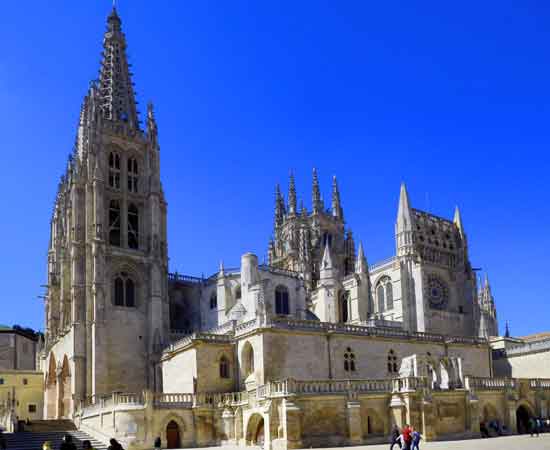
– The cathedral, dedicated to the Virgin Mary, is absolutely stunning! –
It is counted among the most beautiful in Europe, and visiting it alone is worth the trip to Castilla y León’s capital.
Construction began in 1221, inspired by the great French Gothic cathedrals of the time, and was completed over five centuries later. It is the first Gothic cathedral in the Iberian Peninsula.
Thanks to the many works of art it houses, it is the only cathedral in Spain declared a UNESCO World Heritage Site.
Even from the outside, the beauty and grandeur of the building are evident. Its tall and slender structure features two square towers crowned with spires adorned with intricate stonework, towering above the main entrance facing Plaza de Santa María.
The Puerta del Sarmental, another entrance opening onto Plaza del Rey San Fernando, boasts an elaborate sculptural ensemble depicting a Christ Pantocrator surrounded by apostles and evangelists.

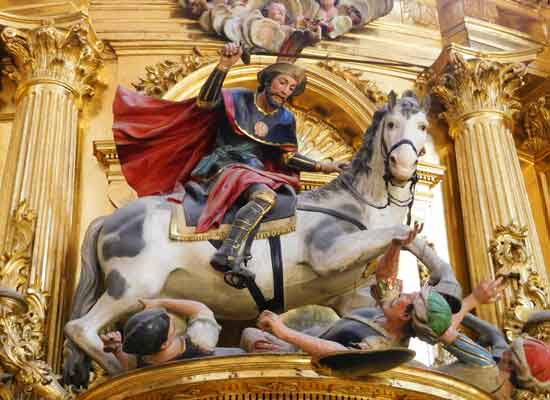
Inside, the central nave and two side aisles are lined with no fewer than nineteen chapels.
It’s impossible to describe them all in just a few lines, given the numerous valuable works of art, including altarpieces, paintings, choir stalls, tombs, and sculptures.
One of the chapels houses the Holy Christ of Burgos, highly venerated since ancient times.
This miraculous wooden crucifix is strikingly realistic, with long natural hair and cowhide to mimic human skin.
Another unique feature is the long bell-shaped skirt covering most of its legs.
Sticking with the pilgrimage theme, I can’t fail to mention the chapel dedicated to Saint James. It features an impressive gilded and polychrome altarpiece presided over by the saint in his “Matamoros” role—portrayed as a warrior on horseback, fighting and defeating the Moors.
After visiting the cathedral, we stroll through the city, taking in Calle Paloma—a central pedestrian street filled with gastronomic, commercial, and cultural offerings.
Spotting a pharmacy, I rush inside and buy two tubes of petroleum jelly.
– After seeing how essential it is for preventing blisters, I don’t want to risk running out again! –
Our initial plan to stay in Burgos for two nights is still in place for me, Rocco, and Dante.
However, we’ve realized that the hostel won’t allow us to stay more than one night, so we’ll need to vacate tomorrow morning.
Finding a solution seems easy enough—we’ll look for another hostel tomorrow for our second night.
With the decision made, we postpone more city exploration until the next day and head back to the hostel for a “collective laundry” session.
By this, I mean using a single washing machine and dryer to wash clothes for multiple people.
Given the level of trust we’ve developed with some of our travel companions, it’s become natural to wash underwear, socks, shirts, and other items together.
This saves both money and time, especially since hostels typically have a limited number of machines, often requiring us to wait our turn.
We end the day by having dinner at a restaurant near the hostel.
Being in a large, touristy city, we find that the “pilgrim menu” is slightly more expensive—14 Euros, or 12 Euros for a more limited selection of dishes.
We settle for the latter option. I order paella, grilled sea bass, and vanilla ice cream for dessert.
The meal is satisfying overall, except for the paella, which once again feels more like risotto than the traditional Valencian specialty typical of fishermen’s galleys.
– Perhaps it’s best if I stop ordering it! –
| © Aldo Lardizzone 2020 |  |
CREATIVE COMMONS |



